Puttin' on the Frits
- Neil Björklund

- Aug 7, 2021
- 12 min read
Updated: Jul 20, 2024
In the central Oregon Cascade Range, as summer pushes on into July and early August, we get into the dreaded fire, smoke and haze season. We also get into the season of nymphalids, or brushfoot butterflies. Many of the skippers, hairstreaks, blues, crescents, and checkerspots of spring and early summer get more scarce or disappear for the season altogether. In their place we see more fritillaries, commas, tortoiseshells and wood nymphs as they come to the fore, especially in those habitats with enough moisture to keep flowers in bloom and to keep puddling spots moist.
The Greater Fritillaries in the genus Speyeria are one of these late season groups in the central Cascades, and they are both challenging and intriguing. Over the past few weeks I took five trips into the central Oregon Cascades with an eye out for fritillaries, and of course whatever else happened to be around. I was initially inspired by Lori Humphreys' sighting of two Coronis Fritillaries on Frissell Ridge on the "4th of July" Butterfly Count on July 17. The previous year, we'd found one worn and tattered Coronis on Frissell Ridge on the count, just north of the Linn County-Lane County line. This year's sightings were in Lane County, which I thought might be a county record. However, Lori had already trumped her own sighting on the count with a Coronis Fritillary at Little Groundhog Mountain on July 3.
For the count I teamed up with Bruce Newhouse, an accomplished botanist, butterflier, all around naturalist and good friend, and we had a splendid day of counting and photographing butterflies on the south half of Frissell Ridge, tallying 28 species for the day, including four species of fritillaries (see full species lists below).
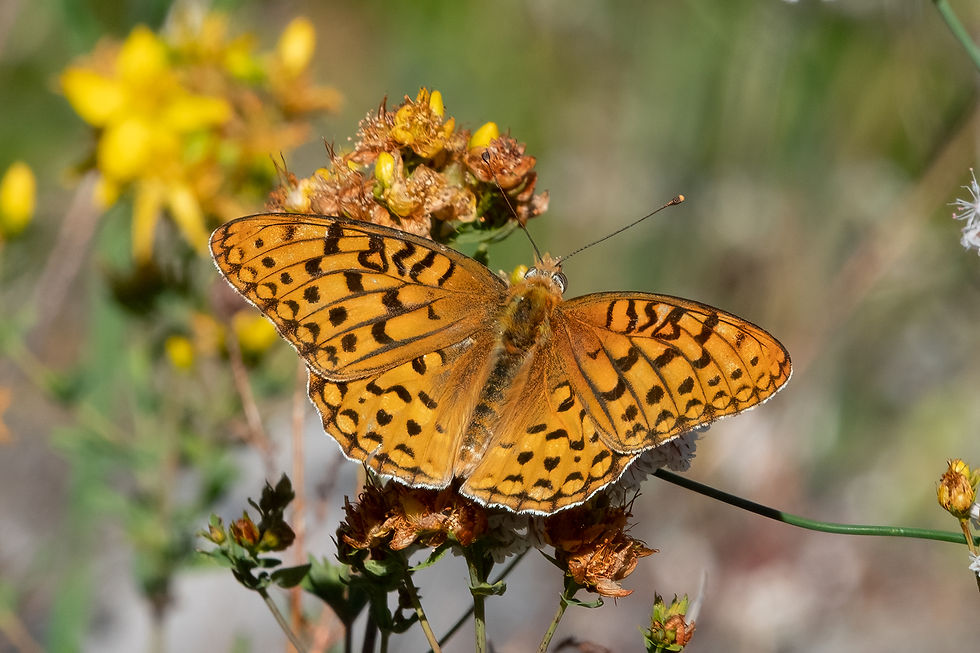
The subspecies of Coronis that we get in Lane County is the central Oregon one, Speyeria coronis simaetha. These are often larger than most of our fritillary species and often noticeably lighter orange on the upper side. On the underside, or ventral side, the silver spots on the hindwing are large and oblong, with brown "shadows" against a tan background. Partly based on last year's sighting, I had assumed that any Coronis we'd find in Lane County would be quite worn, presumably having made a long trip from the high desert. So to see the fresh individual that Lori found on Frissell Ridge got me curious.

On the Butterfly Count, Bruce and I saw one of Lori's Coronis Fritillaries, as well as Northwestern Fritillary (Speyeria hesperis dodgei), Callippe Fritillary (Speyeria callippe elaine) and Hydaspe Fritillary (Speyeria hydaspe minor), though none were in significant numbers. Overall the species diversity for the count was well below average, but we found much higher numbers of Mariposa Coppers (Lycaena mariposa) and Sylvan Hairstreaks (Satyrium sylvinus) than on past counts.

Next up was a visit to Little Groundhog Mountain south of Oakridge with Gary Pearson. Gary had recently posted a photo online of a very small Callippe Fritillary (Speyeria callippe) with strong gray-green shading on the ventral hindwing. I was curious to see and photograph these, so Gary and I decided to visit there on July 23. We knew of a roadside patch of coyote mint (Monardella villosa) on the east slope of the mountain that is a great fritillary magnet, so after some meandering about we headed up there.
The Monardella patch did not disappoint--it was thick with butterflies, especially fritillaries. One of the fun and/or challenging aspects of identifying Speyeria is that each of our 8 species has several subspecies in Oregon, and the subspecies can look very different from each other. To add to the "fun," (e.g., the occasional tearing out of one's hair) a subspecies of one fritillary species can look very much like a subspecies of another fritillary species, so depending on where you are, and which subspecies occur there, you may have a nice ID challenge on your hands. Most likely, you will have to study those fritillaries very carefully, especially the underside pattern, and know which subspecies occur where you are. I have found that there is an extremely small number of people who can quickly and confidently identify all the subspecies of all the species of fritillaries in Oregon. Actually that number is 1. That one person is Paul Hammond at the Oregon State Arthropod Collection. If your name isn't Paul Hammond, the good news is, when you are stumped in trying to identify a fritillary you see, you are in a very large club, and in very good company!
In the case of these little Callippe Fritillaries at Little Groundhog, that green-gray shading on the ventral hindwing is a very good field mark to rule out our other Speyeria species. If that gray-green shading is worn off, and if you haven't seen any fresh individuals, that makes the ID game more challenging.

I spent a good 90 minutes kneeling in the rocks, trying to get a good photo of a fresh Callippe. Time and again, just as I got the camera aimed and ready, a fly, bee or another butterfly would buzz my target and it would fly before I got the shot. Other times, the darn bug would never face the direction that would show its dorsal pattern in the sun. If I moved to get a better angle, it would fly. Even my compatriot Gary got in on the act, excitedly netting a nice fresh, well-marked Callippe that I was also watching (I didn't have my camera on it yet--Gary is very conscientious about not interfering with butterfly photographers). With persistence I did get some satisfying shots of those little Callippes, though none was as fresh and strongly marked with that gray-green shading as I'd hoped. Fortunately, there's always next year!

At this coyote mint patch, the little Callippe Fritillaries were the most numerous, with Hydaspe Fritillaries a close second. We also saw 3 Northwestern Fritillaries (Speyeria hesperis dodgei), 3 large Coronis Fritillaries (Speyeria coronis simaetha), and just as we were leaving, a single female Great Spangled Fritillary (Speyeria cybele pugatensis) flew over the car. The 22 species we saw in total were fewer than I typically see at this site in early July, when its rare to see fewer than 30 species.

The following day, I decided to visit Box Canyon Meadows, another good late season site north of Oakridge in Lane County. When I arrived, the meadows appeared to be in good condition, and lots of nectar plants were blooming. I stepped out of the car and looked around, and within a couple of minutes I noticed that I couldn't see a single butterfly flying. Which was very strange for a warm sunny day in late July at an excellent meadow site.
In the first 30 minutes I saw so few butterflies that I nearly decided to pack it in and l head home. Instead, I did a little scouting of some nearby Forest Service roads that I hadn't been on, looking for patches of Golden Chinkapin (Chrysolepis chrysophylla), the larval host plant for the Golden Hairstreak (Habrodais grunus). My scouting route eventually took me back through the main meadows and I decided to stop and commit to spending a couple hours searching the full extent of the meadows. What I found was a somewhat unusual combination of high species diversity with very low numbers. For example, in the past at this time of year I had seen many Mormon Fritillaries (Speyeria mormonia erinna) here, but on this beautiful day, I had to work hard to find just 3. Western Branded Skippers (Hesperia colorado nr. oregonia), Anna's Blue (Plebejus anna ricei) and Common Wood Nymphs (Cercyonis pegala incana) were the most common species, with most others just represented by one or a few individuals.

As I ate my lunch, it occurred to me that I had never searched in the small sun-dappled meadows in the patch of forest at the north end of the main meadows. I wandered over there after lunch, and chased a couple of fritillaries that I could neither catch up with nor identify. As I was walking out of the forest, a large, bright female Great Spangled Fritillary (Speyeria cybele pugatensis) flew past me and then back into the small clearing I had just walked through. It's uncommon for me to get a good opportunity to photograph a fresh female Great Spangled, so I turned back to follow it. It didn't appear to be laying eggs, or even looking for host plants. It would fly around a bit, then perch. Then do it again. I followed it through several cycles of this behavior before I had a good angle from a close enough position. Fortunately it was in the sun, and I wasn't. Click! I only saw that one Great Spangled that day, so I was grateful to get a photo of her.
However, she was not the only fritillary frolicking in the forest. Remember those two Speyeria that I hadn't caught up with? After thinking for the second time that I was ready to call it a day, another orange fritillary zipped across one of the small openings in the forest--only this one was large and pale orange. It seemed to have the same modus operandi as that female Great Spangled (flying, perching, flying, perching, etc.). Again, I couldn't detect any ovipositing activity. I wondered if it was newly eclosed, and not at full flight strength yet.

Just like the Great Spangled female had done, this one landed in a small sunny opening in the forest. Again I used the shadows to cloak my very slow approach, and again it worked. I got close enough for a good ventral view, and saw those large, oblong silver spots on the hindwing, with brown shadows on a tan background. Amazing! This was my 6th Coronis Fritillary in Lane County this year!
A week later I decided to visit the grassy meadows around Lost Lake in Linn County, just over the Cascade Crest on Highway 20. I was partly inspired by past reports of Checkered Whites at this site, so in addition to the fritillaries, I had my eye out for whites.
Thus far in 2021, I had seen very few California Tortoiseshells, a brushfoot species whose populations mysteriously boom and bust from year to year. On the mudflats at the edge of the summer remnant of the lake, I saw several times more of them than I'd seen everywhere else this year combined. My estimate of 75 individuals was likely greatly under-representative. The other dominant species was Western White, a species I had never seen in such numbers before at any single site.
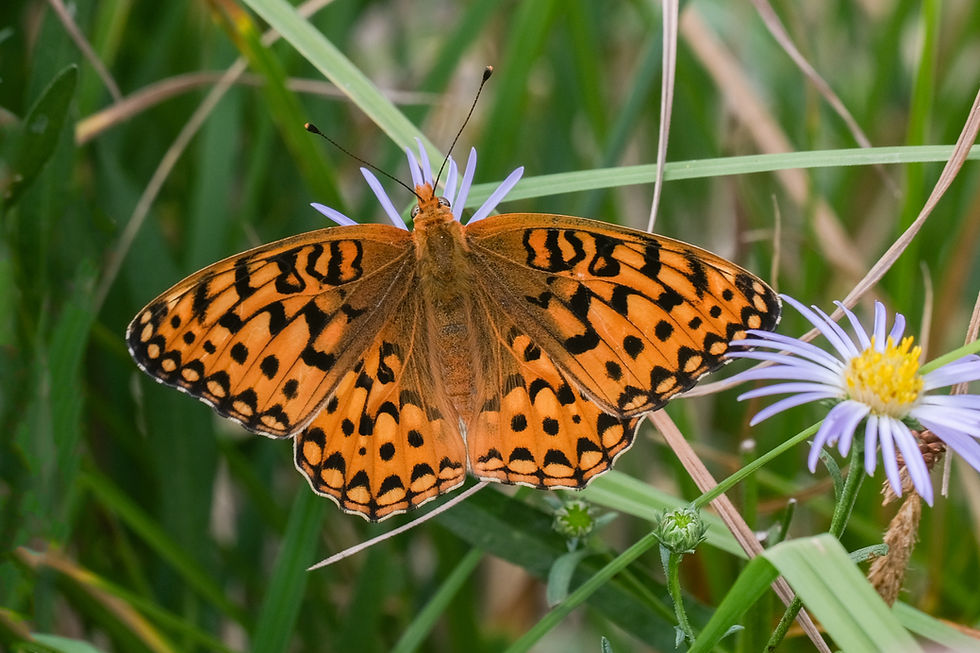
After chasing whites through the grassy meadow, and photographing commas on the mud flats, I made my sweaty way back to the car for lunch. While I was munching on crackers and black bean dip, I noticed a very bright orange fritillary nectaring in a small patch of asters in a shady spot to my left. I set my half-eaten lunch down, grabbed my camera and walked over there. Since I over the crest of the Cascades, I knew I had a chance at a couple of east side Speyeria species including Zerene Fritillary (Speyeria zerene picta) and possibly (wishfully) Great Basin Fritillary (Speyeria egleis moecki).
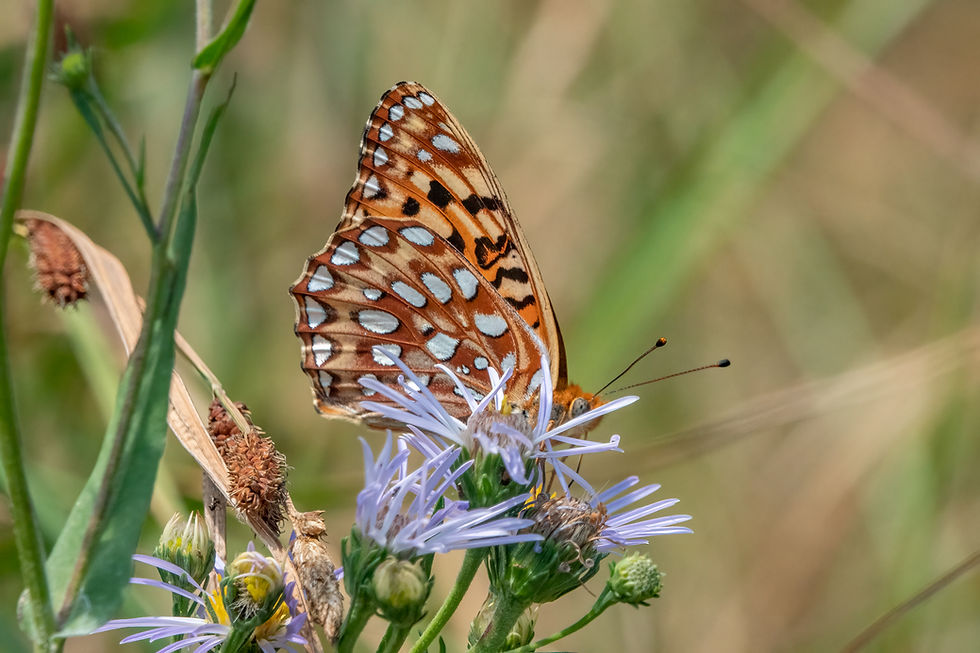
When I got close enough to get a good look through my binoculars, I knew I had a Zerene. The bold pattern of elongated silver spots on the ventral hindwing, with bold red shadows on a tan background is distinctive. It was kind enough to hang around long enough to allow me to get both ventral and dorsal photos, always a great luxury with Speyeria.
Back at my car, resuming my lunch, I had the thought that this might be the closest site to Eugene for Zerene Fritillary, given that the Willamette Valley subspecies (Speyeria zerene Willamette Valley segregate) is now considered extinct. Later, I realized it was possible that one of the smaller coastal populations of the Oregon Silverspot (Speyeria zerene hippolyta) might be closer. That sequence of thoughts led me to make a date with the Oregon Silverspot later in August!
In all, I found 12 species at Lost Lake, and got a lot of practice identifying Western Whites--making sure they weren't Checkered Whites. I saw two more Zerene Fritillaries on the mud flats, along with a dozen Hoary Comma (Polygonia gracilis zephyrus), a Green Comma (Polygonia faunus rusticus), and a Mourning Cloak (Nymphalis antiopa antiopa).
After my Lost Lake trip, I now had six Speyeria species in this run. It seemed like a good idea to keep going and try for Mormon Fritillary (Speyeria mormonia erinna) also. So my last trip of this Speyeria series was a visit to the Scott Lake area along Highway 242 in eastern Lane County, on the edge of the grand and glorious Three Sister's Wilderness. My friend Magnus Persmark joined me for the day, and our plan was to focus on birding, especially in the morning, and to spend some time with the butterflies in the afternoon. I let Magnus know that I was keen on photographing Mormon Fritillary, and since that would be a new species for him, that was no problem.
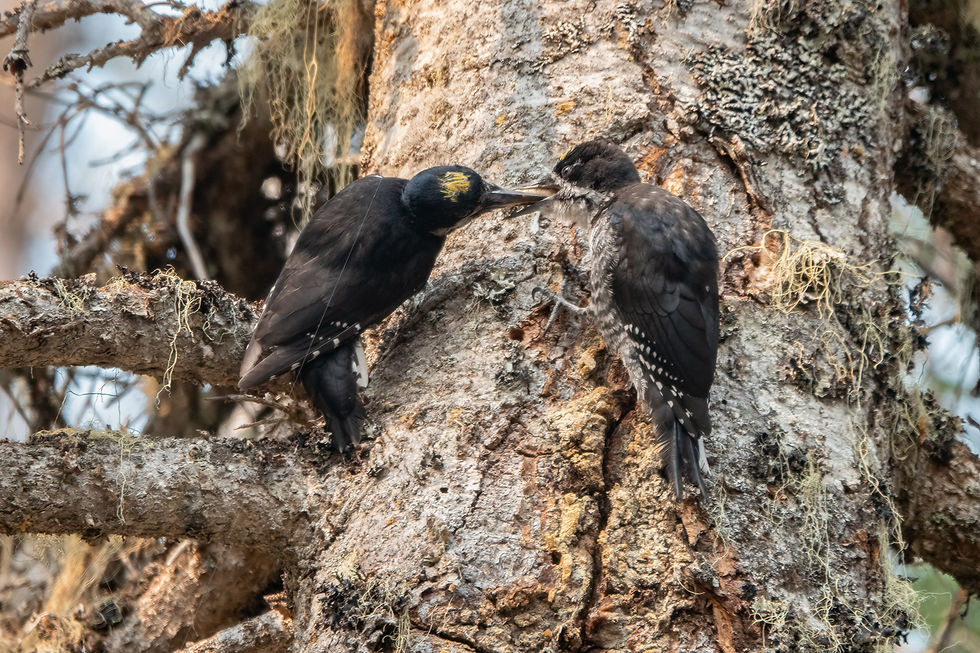
The first spot we explored was a burned area south of Scott Lake, with a dry stream channel that was supporting a lot of wildflowers. After finding and watching a family threesome of Black-backed Woodpeckers in the morning, there was a "whole lot of nothing" going on with the birds, so although we kept trying, we had much better luck with the butterflies.
After an hour or two of dismal birding, we spontaneously and melodramatically dubbed our birding experience the "Silence of the Birds" (cue the spooky background music). We joked a lot about how incredibly quiet it was in terms of bird sightings, songs and sounds. Lots of birds are molting (losing their old feathers and growing new ones) this time of year so they are naturally more quiet and hidden, but this day was extremely quiet! We speculated that perhaps the heavy wildfire smoke in the area the day before might have further dampened the birds' singing, and perhaps driven some birds off the ridge in search of cleaner air.
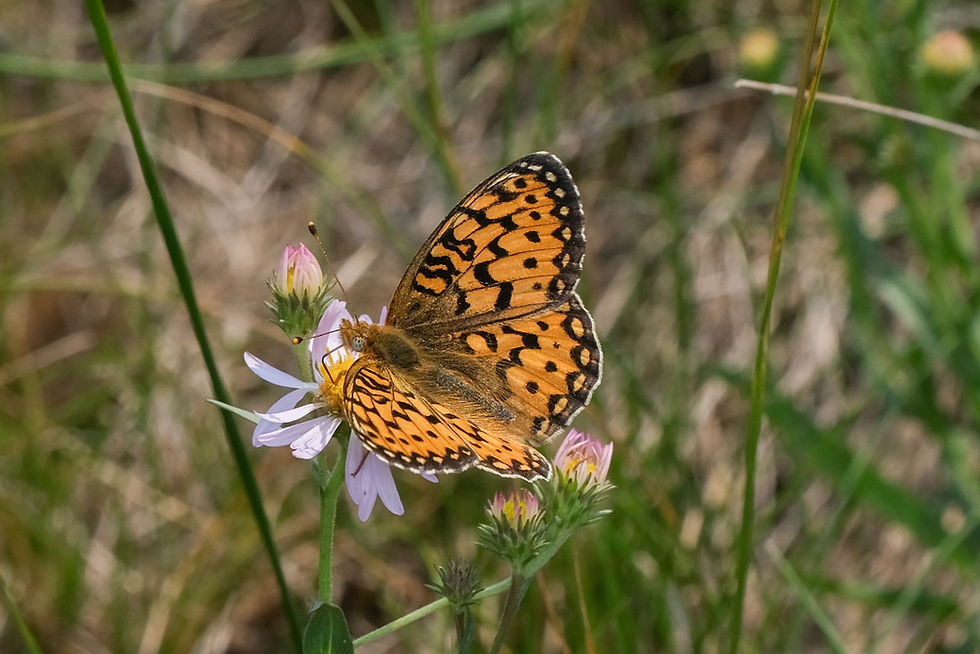
From my past visits to the area, I knew that it would not be hard to find Mormon Fritillaries flying this time of year. Indeed, we saw them at each of the sites. However, the second site, Hand Lake, was hands down the hotspot for them. I counted 25, but there were likely several times that number. The lower areas and the partially shaded fringes of the meadow sported healthy patches of asters and that's were the fritillaries were. We continued cracking jokes about the Silence of the Birds as we walked through the meadows to the lake and then down to the south end of the meadows.

We saw lots of the Mormon Fritillaries zipping around the large meadow, but we just couldn't get close enough to them for photos. After slowly zig-zagging through most of the meadow, we finally found one--perhaps very recently eclosed--that wasn't so skittish and zippy. We snuck up to it and got some nice photos of it nectaring. Then we spotted another Coronis Fritillary a ways off, but again couldn't get close to it. About the time our grumbling stomachs started hollering at us to head back to the car, another Coronis came into view and landed not far from us--a poser. This would be my 7th Coronis Fritillary in Lane County this year!

The final site of the day was the nearby Summit Meadow, tucked amongst the trees on the east side of Highway 242. The light was just beginning to fade as the orange haze-dampened sun sank lower in the west. We spent about a half hour walking around the meadow and saw mostly Mormon Fritillaries, and one Hydaspe. Then at the far end of the meadow, a nice look at yet another Coronis fritillary--my 8th in Lane County in less than 3 weeks!
In all my previous years of chasing, watching and photographing butterflies in Lane County, I had never seen a Coronis Fritillary in the county. So seeing 8 of them in the last 3 weeks across 5 different sites in Lane County was astounding! It might not be enough to call it an irruption of the species into Lane County, but it really stands out among my sightings this summer.
Over these last five trips, I recorded 50 total species and over 1,000 individuals. It was especially satisfying to find and photograph all 7 of the Speyeria species that occur in the central Cascades. I'd missed only the Great Basin Fritillary (Speyeria egleis moecki) among our 8 Oregon species (and that would be a very rare find in this area). It was a great opportunity to practice identifying Speyeria in the field, as well as back home while going through my photos. It's not that uncommon for me to revise an ID of a fritillary after studying my photos at home, or to send a photo to someone more skilled in their identification than I am. I did revise one of my IDs from Frissell Ridge based on photos, realizing that I had mistaken a Speyeria hesperis dodgei for a dark Speyeria hydaspe minor. No shame there! These Speyeria can stump the best of us.
Several of my friends and colleagues have suggested that I create a guidebook to the Greater Fritillaries of Oregon based on photos of live butterflies. Certainly, I see how helpful that would be for folks trying to ID them in the field. I continue to ponder the idea. I will likely take an inventory of which subspecies I am missing the fall just to see where I stand. And I do plan to go after the Oregon Silverspot yet this summer, so that would add another Zerene Fritillary subspecies to my portfolio. Honestly, it would be great fun to get out to the NE and SE corners of the state and to the Warner Mountains to photograph those Speyeria subspecies that I haven't captured with my camera yet. For now, though, my mind is on finding those elusive last 5 species that are breeding (theoretically, at least sporadically) in Oregon: Checkered White, Spring White, American Copper, Gillett's Checkerspot and Compton's Tortoiseshell.
Here's to clean air, and healthy habitats!
Frissell Ridge, Lane County, July 17, 2021, 28 species:
Little Groundhog Mountain, Lane County, July 23, 2021, 22 species:
Box Canyon Meadows, Lane County, July 24, 2021, 28 species:
Lost Lake, Linn County, August 1, 2021, 12 species:
Scott Lake Area, Lane County, August 4, 2021, 15 species:



Comments